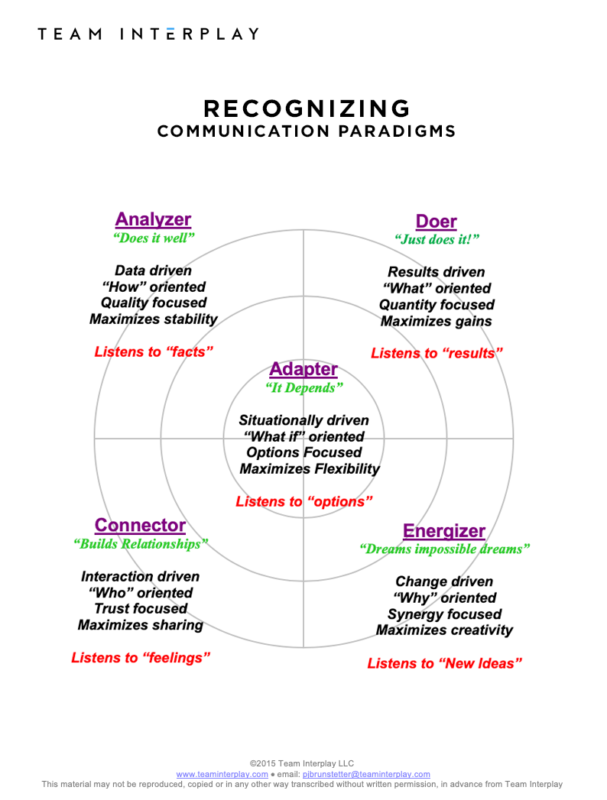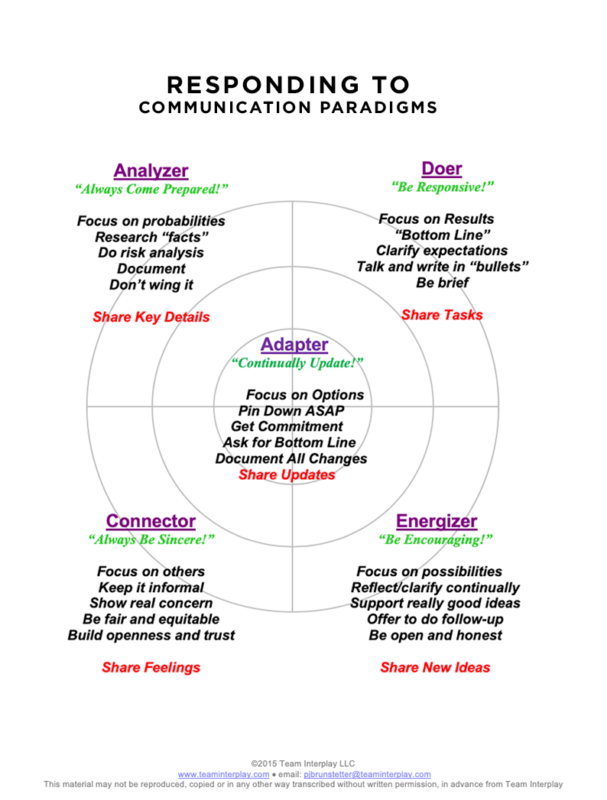Research
The Five (5) Communication Paradigms
Chemistry Code to Accelerate Team Performance
P. John Brunstetter, PhD
After action research involving over 30k profiles and based on coaching many leaders and teams, here is what we have learned about how to measure & use work chemistry tools to increase your teams’ performance:
A Common Skill Deficiency
Most team leaders listen VERY SELECTIVELY based on their own pre-conceived biases and perceptions. We learned that Team leaders tend to listen best when discussing short term goal achievement or ways to reduce their work stress and pain. Most teams were routinely led by formal leaders, “appointed” by management. Many believed that leadership required them to control the people under them and their results. I also discovered informal or “natural” leaders, who operated very effectively under the formal leaders without much, if any formal authority or title.
Natural Leader
Mysteriously, the few effective team leaders that emerged, were seldom the formal leaders. “Natural leaders” arose and seemed to flourish, using their “personal power” rather than “position power”. I was fascinated by their apparent innate ability to connect with those around them. These natural leaders, quickly learned, spoke, and internalized the key “lingo” spoken at every level of the organization. As a result, they were able to communicate well, build trust and create positive chemistry with everyone. Co-workers believed these natural leaders always “had their back” and could be trusted more than the formal leaders. On rare occasions natural leaders were also formal leaders. We also discovered that we could teach formal leaders how to use “personal power”, effectively.
Cracking the Team Chemistry CODE
Early in my training and development career, we learned that, if the companies we served were to improve, they could not depend solely on the few “Natural Leaders” they had buried in their ranks. We studied these “natural leaders” hoping to discover what made them so effective. We wanted to “test” our theories about work chemistry and then develop validated tools to empower potential leaders who did not necessarily have all the natural gifting.
Key Factors Discovered
In our research, done at Southern California Edison & Xerox, we discovered 20 key factors that quantitatively measure team chemistry. We have honed these findings and created tools to help thousands of team leaders/ teams. We can now measure, predict and improve work chemistry and team performance using the following components of The Work Chemistry Profile”:
- Positive Behavioral Styles
(What is your work style “comfort zone”?) - Behavioral Style under Stress
(What is your work style “stress zone”?) - Comfortable Decision-Making Patterns
(What are your comfortable decision patterns?) - Stress Decision Making Patterns
(What are your decision patterns under stress?) - Motivational Drivers
(What influences and predisposes your work behavior?)
Systematic Leader Training
We teach leaders how to use these “communication paradigms” to increase their work chemistry. We show leaders and members, how to speak in ways that use other’s lingo. We show them how to use different communication languages to accelerate trust, openness, and full engagement. Increasing Work Chemistry begins with Behavioral Styles and later involves mastering Decision-Making and Motivation.
The following two charts are a “short cut” to learning How to Recognize & How to Respond to others.


